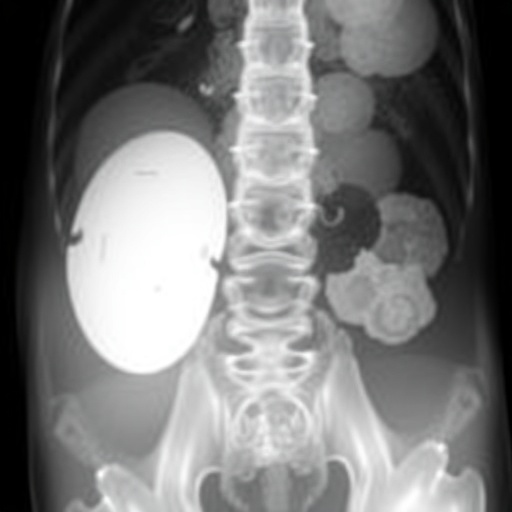A recently documented medical case highlights an exceptionally rare instance of a vulvar mucinous cyst that presented clinically as a common benign lesion, complicated further by the simultaneous presence of multiple Bartholin gland cysts. This unique presentation occurred in a 36-year-old reproductive-age woman, underscoring the complexities inherent in gynecological diagnostics when dealing with atypical vulvar masses. The findings were meticulously reported by researchers Naina Kumar, Immanuel Pradeep, Banka Sai Swetha, and Pooja T. Rathod from the All India Institute of Medical Sciences, Bibinagar, and published in the October 2025 issue of the peer-reviewed journal Oncoscience.
Vulvar cysts are a heterogeneous group of lesions that predominantly exhibit benign behavior. Among these, Bartholin gland cysts are relatively common and well-characterized; however, mucinous cysts of the vulva are exceedingly rare entities, often overlooked or misdiagnosed due to their striking resemblance to more prevalent soft tissue growths such as lipomas or fibroepithelial polyps. These mucinous cysts are lined by mucinous columnar epithelium, a histological feature that signifies their glandular origin and differentiates them from typical cutaneous cysts. The challenge lies in their clinical similarity to benign masses, which can delay accurate diagnosis and appropriate treatment strategies.
The subject of the case was a multiparous woman who presented with non-specific complaints, including persistent lower abdominal and back pain, alongside her initial episode of prolonged menstrual bleeding—symptoms that initially appeared unrelated to vulvar pathology. Clinical examination revealed a large, soft, pedunculated mass on the left labia majora. The lesion’s appearance closely mimicked a lipoma, a benign fatty tumor commonly encountered in soft tissue diagnoses. Additionally, smaller cystic lesions were noted bilaterally on the inner labia minora, clinically consistent with Bartholin gland cysts. This concurrent presentation inadvertently complicated the clinical picture.
Subsequent surgical excision of all identified lesions provided the means for comprehensive histopathological evaluation. The large mass was confirmed as a mucinous cyst, characterized by a lining of mucinous columnar epithelium devoid of malignant features. The smaller inner labial cysts were histologically consistent with Bartholin gland cysts. This dual pathology within the same anatomical region in a reproductive-age woman is exceptionally unusual and has significant implications for differential diagnoses in gynecologic practice.
Mucinous cysts of the vulva originate from glandular structures and are thought to arise due to obstruction of mucinous glands or developmental anomalies. Their rarity contributes to the diagnostic difficulty, particularly when their clinical presentation closely mimics other benign vulvar lesions. Importantly, these cysts can be asymptomatic and go undetected unless they achieve a size sufficient to cause discomfort or are incidentally discovered during clinical examinations for unrelated complaints.
From a histological perspective, the mucinous cyst’s lining exhibits apical mucin, a distinctive feature visualized under high magnification with hematoxylin and eosin staining. This mucin production plays a crucial role in the cyst’s secretory function but also aids in differentiating it from other cystic lesions lacking such epithelial characteristics. Bartholin cysts, conversely, are derived from obstruction of the Bartholin glands, situated at the posterior vestibule of the vulva, and typically contain mucinous secretion lined by squamous or cuboidal epithelium, differentiating them histopathologically from mucinous vulvar cysts.
This case underscores the critical importance of a thorough clinical and pathological assessment of vulvar masses. The pitfall in assuming benignity based on superficial clinical characteristics alone is significant, as the presence of rare cyst types may warrant a different therapeutic approach and follow-up strategy. Surgical excision not only provided symptomatic relief but also confirmed the benign nature of these lesions, negating the need for further oncologic intervention.
Given that vulvar lesions can be mistaken for benign soft tissue tumors such as lipomas, the clinical takeaway involves heightened awareness for gynecologists and general practitioners alike. Uncommon presentations should trigger consideration of rare pathological entities, prompting complete surgical removal and detailed histopathological scrutiny to ensure accurate diagnosis.
The documentation of this rare mucinous cyst alongside common Bartholin cysts fills a critical gap in the medical literature regarding female reproductive tract cystic lesions. It broadens the spectrum of vulvar masses and enriches existing knowledge on their varied presentations, which is essential for guiding diagnostic algorithms and treatment paradigms. This knowledge is particularly relevant to gynecological oncologists and pathologists who are involved in the care of women with vulvar abnormalities.
Postoperative outcomes in this patient were favorable, with complete recovery and scheduled routine follow-up visits recommended to monitor for potential recurrence or complications. The benign pathology allowed for a conservative post-surgical management plan, underscoring the value of accurate diagnosis in optimizing patient care pathways.
In conclusion, this rare case report from the All India Institute of Medical Sciences emphasizes that vulvar mucinous cysts, while infrequent, should be incorporated into the differential diagnosis of vulvar masses, especially when the clinical presentation deviates from the classical appearance of more common cystic lesions. Surgical excision followed by histopathological examination remains indispensable for definitive diagnosis, ensuring that rare yet benign conditions are accurately identified and appropriately managed.
The research also illustrates the growing need for heightened vigilance in the clinical evaluation of vulvar lesions in reproductive-age women, who may present with non-specific symptoms or asymptomatic masses. The ability to distinguish between various cystic entities has direct repercussions for patient counseling, treatment planning, and prognostication.
Published in the open-access journal Oncoscience, this case contributes to a growing body of literature aimed at refining diagnostic accuracy and improving outcomes in gynecologic pathology. The study’s absence of conflicts of interest and its open-access nature underscore its commitment to advancing shared knowledge in the medical community. Researchers, clinicians, and healthcare professionals are encouraged to consider rare vulvar cyst types as potential diagnoses and to incorporate comprehensive pathological assessment in their practice.
The full article is accessible through the DOI: 10.18632/oncoscience.630 for those seeking in-depth examination of the clinical presentation, surgical management, and histopathological findings. This case not only advances scientific understanding but also serves as a crucial clinical reminder of the diverse manifestations of vulvar cysts and their implications in women’s health.
Subject of Research: People
Article Title: Vulvar mucinous cyst mimicking common lesions with concurrent multiple bartholin cysts in a reproductive-age woman: A rare case report and review of literature
News Publication Date: October 9, 2025
Web References:
Original article DOI link
Oncoscience Journal
Image Credits: Copyright: © 2025 Kumar et al. This is an open access article distributed under the terms of the Creative Commons Attribution License (CC BY 4.0), permitting unrestricted use, distribution, and reproduction with proper credit.
Keywords: cancer, bartholin cyst, gartner’s cyst, lipoma, mucinous cyst, vulva
Tags: atypical vulvar massesBartholin gland cystsbenign vulvar lesionscase report on vulvar cystscomplexities in gynecological diagnosticsdiagnostic challenges in gynecologyhistological features of mucinous cystsmedical research in gynecologymisdiagnosis of vulvar growthsrare vulvar cyst casesreproductive age women healthvulvar mucinous cyst





